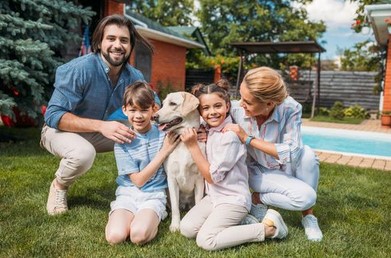No one knows and appreciates spending time in the family yard (a.k.a. “backyarding”) like the family dog. During the pandemic, pet ownership has increased, and pets have provided companionship, consistency and joy to families over the last year especially.
According to science, pet ownership is good for us. Dog owners are also more likely to engage in moderate to physical activity, walking an average of 300 minutes per week compared to 168 minutes per week for those without a dog. Also, a review of studies by the American Heart Association found that dog ownership was associated with a 24 percent risk reduction for all-cause mortality as compared to non-ownership.
A Realtor.com survey indicates that three-fourths of home buyers would pass up on their dream home if it wasn’t right for their pet. Furthermore, pet owners say a large yard (45 percent) and outdoor space (36 percent) were the most important home features.
So how can Realtors® get buyers thinking about a backyard that does more for their family pet? The Outdoor Power Equipment Institute (OPEI) offers these suggestions.
Focus on grass. Grass is one of the best ground coverings around because it can handle the wear and tear that comes with pets. Bermuda and buffalo grass are especially hardy varieties, though your buyer should install a variety that is right for their climate zone. This is the environmentally friendly choice, and it saves on water usage.
Sell the shade. Dogs need a place to relax away from the sun after a day of play. A tree or bush can provide the perfect respite.
Address activity areas. It’s a good idea for pet parents to train their dogs to do their business in a certain area of the yard. Sturdy, yet soft foliage can create a natural barricade between that space and the rest of the lawn. Shrubs make a pretty – and effective – barrier for vegetable gardens and flower beds.
Point out pet potential. Not every yard is set up to pamper a pet, but point out the potential to create a pet paradise. Is there room to build a pergola for additional shade? Could a fence easily be installed? Maybe there’s a perfect spot for a shallow water feature that could help hot pets cool off. A canine obstacle course can provide hours of fun if the space is available to install one.
Look for hazards. Pets don’t know the difference between plants that are okay for them and those that are not. A few common toxic plants for dogs are: carnations, chrysanthemums, daffodils, hostas, ivy, lilies, morning glories, tomatoes, and tulips. For a complete list, visit ASPCA’s list of non-toxic and toxic plants.
To learn more go to TurfMutt.com.
To learn more, go to TurfMutt.com.

